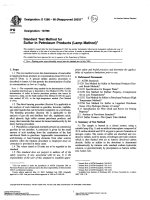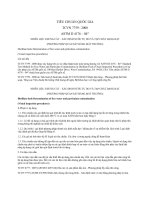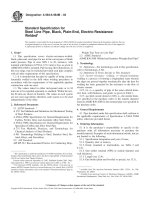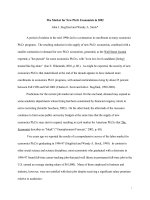Astm d 984 97 (2002)
Bạn đang xem bản rút gọn của tài liệu. Xem và tải ngay bản đầy đủ của tài liệu tại đây (61.98 KB, 5 trang )
Designation: D 984 – 97 (Reapproved 2002)
Technical Association of Pulp and Paper Industry
Standard Method T 406 Su-72
An American National Standard
Standard Test Methods for
Reducible Sulfur in Paper1
This standard is issued under the fixed designation D 984; the number immediately following the designation indicates the year of
original adoption or, in the case of revision, the year of last revision. A number in parentheses indicates the year of last reapproval. A
superscript epsilon (e) indicates an editorial change since the last revision or reapproval.
impregnated with lead acetate. The intensity of the spot is
compared with spots developed from standards and is proportional to the concentration. No colorimeter or spectrophotometer is needed for this method.
4.2 Method A, the quantitative method, uses the identical
reduction system to generate hydrogen sulfide, but the sulfide
is precipitated by alkaline cadmium sulfate and then converted
to
methylene
blue
by
reaction
with
acidic
p-aminodimethylaniline in the presence of ferric chloride. The
methylene blue is measured spectrophotometrically and the
intensity is compared with standards prepared in similar
manner.
1. Scope
1.1 These test methods cover the determination of reducible
sulfur in paper and paperboard within the context of the given
definitions.
1.1.1 Method B—The semiquantitative method indicates the
general level of reducible sulfur with limited accuracy.
1.1.2 Method A—The quantitative method gives a measure
of the reducible sulfur with much greater accuracy.2,3
1.2 This standard does not purport to address all of the
safety concerns, if any, associated with its use. It is the
responsibility of the user of this standard to establish appropriate safety and health practices and determine the applicability of regulatory limitations prior to use.
3. Terminology
3.1 Definitions—Definitions shall be in accordance with
Terminology D 1968 and the Dictionary of Paper.5
5. Significance and Use
5.1 The test methods outlined are not necessarily a measure
of how much a given test material will tarnish polished metals.
When tested by these methods, paper that has less than
0.0008 % reducible sulfur, may be assumed to be nontarnishing
as far as sulfur is concerned, but if more than 0.0008 %, this
does not necessarily mean that tarnishing will occur, because
sulfur compounds which may not cause staining are reduced by
the treatment with the subsequent evolution of hydrogen
sulfide. If more than 0.0008 % reducible sulfur is found, or if
the effect of that or other materials causing stains on silver is
desired, the paper should be subjected to an accelerated
tarnishing test (see Test Method D 2043).
4. Summary of Test Methods
4.1 Method B, semiquantitative method, involves the reduction of various forms of sulfur to hydrogen sulfide and the
development of a dark spot of lead sulfide on the filter paper
NOTE 1—If the pH of the paper is low (for example, 4.0 to 4.5 (cold
extraction)) as little as 0.0002 % of reducible sulfur may cause tarnishing
of imitation gold bronze prints; whereas, if the pH were higher, (for
example, on brush-coated art paper) a much higher quantity of sulfur
might be tolerated.
2. Referenced Documents
2.1 ASTM Standards:
D 585 Practice for Sampling and Accepting a Single Lot of
Paper, Paperboard, Fiberboard, and Related Product4
D 644 Test Method for Moisture Content of Paper and
Paperboard by Oven Drying4
D 1968 Terminology Relating to Paper and Paper Products4
D 2043 Test Method for Silver Tarnishing by Paper4
5.2 The test methods described do not give the total sulfur
content, nor the total reducible sulfur content, nor are they
intended to. They are limited to the reducible sulfur content
determined under the conditions of the test (that is, a fairly
mild reduction system).3
5.2.1 Those forms of sulfur believed to be “reducible” under
the test conditions are (1) sulfide (released by the acid, not
actually reduced), (2) elemental sulfur, (3) thiosulfate, (4) other
polythionates or polysulfides, and (5) perhaps sulfite. Sulfate is
excluded.
1
These test methods are under the jurisdiction of ASTM Committee D06 on
Paper and Paper Products and are the direct responsibility of Subcommittee D06.92
on Test Methods.
Current edition approved Dec. 10, 1997. Published November 1998. Originally
published as D 984 – 48 T. Last previous edition D 984 – 92 (1996).
2
Sobolev, I., Bhargava, R., Gosuntov, N., and Russell, R., Tappi 39(9):
628(1956).
3
Chazin, J. D., “Colorimetric Determination of Reducible Sulfur in Paper and
Paperboard,” Tappi, Journal of the Technical Association of the Pulp and Paper
Industry, TAPPI, Vol 53, No. 8, 1970, p. 1514.
4
Annual Book of ASTM Standards, Vol 15.09.
5
Available from the Technical Association of the Pulp and Paper Industry, P.O.
Box 105113, Atlanta, GA 30348.
Copyright © ASTM International, 100 Barr Harbor Drive, PO Box C700, West Conshohocken, PA 19428-2959, United States.
1
D 984 – 97 (2002)
where such specifications are available.6 Other grades may be
used, provided it is first ascertained that the reagent is of
sufficiently high purity to permit its use without lessening the
accuracy of the determination.
9.2 Purity of Water—Unless otherwise indicated, references
to water shall be understood to mean distilled water.
9.3 Aluminum Foil, 1145 alloy, plain (or aluminum weighing pans), not over 0.01 in. (0.25 mm) sulfur-free.
9.4 Amine Solutions:
9.4.1 Stock Amine Solution—Dissolve 25 g of
p-aminodimethylaniline
sulfate
(N,N-dimethyl-pphenylenediamine sulfate) in 75 mL of cold sulfuric acid
(1 + 1) and dilute to 100 mL with the (1 + 1) acid.
9.4.2 Dilute Amine Solution—Pipet 2.5 mL of the stock
solution into a 100 mL volumetric flask and dilute to the mark
with sulfuric acid (H2SO4)(1 + 1).
9.5 Cadmium Hydroxide Absorption Suspension—Dissolve
4.3 g of cadmium sulfate (3CdSO4·8H 2O) in water; add 0.3 g
of sodium hydroxide (NaOH) dissolved in water and 10 g of
arabinogalactan: dilute to 1000 mL and stir well. This is a
saturated solution of cadmium hydroxide; the suspension is
swirled before pouring off an aliquot.
9.6 Ferric Chloride Solution—Dissolve 100 g of ferric
chloride hexahydrate (FeCl3·6H 2O) in water and dilute to 100
mL.
9.7 Nitrogen Gas, sulfur-free.
9.8 Phosphoric Acid—Concentrated phosphoric acid
(H3PO4) (sp gr 1.69) sulfur-free.
9.9 Sodium Sulfide Standard Solutions (use water deaerated
with nitrogen).
9.9.1 Stock Solution—Dissolve 1.56 g of sodium sulfide
nonahydrate (Na2S·9H 2O) (use large crystals which appear
dry) in the deaerated water and dilute to 1000 mL. Pad the
space over the solution with nitrogen, and renew each time the
solution is used. Solution should be stable for 1 month.
9.10 Working Solution— Pipet 10.0 mL of stock solution
into a 1000-mL volumetric flask and dilute to the mark with the
deaerated water. 1 mL of this solution contains 2 µg of sulfur
(that is, solution is 2 ppm in sulfur). Prepare solution daily.
6. Sampling
6.1 Obtain the sample in accordance with Practice D 585.
6.2 A minimum of 6 g of sample is required to provide
triplicate test specimens.
6.3 Do not touch the test area of sample or test specimens
with the fingers; handle with clean forceps only.
7. Test Specimens
7.1 From each test unit of the sample, cut and weigh 2 g to
the nearest 1 mg for each test unit.
7.2 Determine the moisture content in accordance with Test
Method D 644.
METHOD A—QUANTITATIVE MEASUREMENT
8. Apparatus
8.1 Reaction Apparatus (Fig. 1), consisting of a 500-mL
FIG. 1 Reaction Apparatus (Quantitative Determination).
round-bottom three-necked flask as illustrated, equipped with a
gas inlet tube adapter with perforated bulb, a 60-mL pearshaped funnel, a 200-mm West condenser, a side-arm adapter,
and a heating mantle with variable power supply.
8.2 Absorption Apparatus (Fig. 1), consisting of a 100-mL
amber or low-actinic flask in a suitable ice bath.
8.3 Colorimeter or Spectrophotometer to read at 660 to 670
nm equipped with 1-in. cells or 25 to 50-mm cuvettes.
8.4 Pipets—1, 2, 5, and 10-mL serological or bacteriological (blow-out).
8.5 Other Equipment—100 and 1000-mL volumetric flasks;
medicine droppers; 10 and 100-mL graduated cylinders; forceps; 10.0-mL volumetric pipets.
8.6 Disintegrator—A blender or other such rotating-blade
device with a small volume container, if possible.
8.7 Optional Equipment—A constant-temperature bath,
maintained at 20 to 25°C.
NOTE 2—This solution or the stock solution may be standardized by
potentiometric titration with silver nitrate solution using a sulfide-specific
electrode; the sulfide standard should be at least 90 % pure.
10. Procedure
10.1 Disintegrate the sample in the blender with 75 mL of
water and transfer the test specimen from the disintegrator
quantitatively to the 500-mL reaction flask using additional
aliquots of 5 mL of water to assist in the transfer. Add 2 g of
aluminum foil (or one aluminum foil weighing dish) which has
been cut into 1⁄2-in. (12.7-mm) squares and complete the
assembly of the reaction apparatus.
10.2 Precipitation of Cadmium Sulfide:
9. Reagents and Materials
9.1 Purity of Reagents—Reagent grade chemicals shall be
used in all tests. Unless otherwise indicated, it is intended that
all reagents shall conform to the specifications of the Committee on Analytical Reagents of the American Chemical Society,
6
“Reagent Chemicals, American Chemical Society Specifications,” Am. Chemical Soc., Washington, DC. For suggestions on the testing of reagents not listed by
the American Chemical Society, see “Reagent Chemicals and Standards,” by Joseph
Rosin, D. Van Nostrand Co., Inc., New York, NY, and the “United States
Pharmacopeia.”
2
D 984 – 97 (2002)
of the calibrated standards versus micrograms of sulfur present
and draw the best straight line passing through zero. (The slope
should be about 0.005 to 0.010 absorbance units per 1 µg of
sulfur per 10 nm of path length.) Read the amount of reducible
sulfur, in micrograms, in each specimen directly from the chart
based on its net absorbance.
10.2.1 Measure 10 mL of the concentrated H3PO4 (sp gr
1.69) into the dropping funnel and 75 mL of the cadmium
hydroxide absorption suspension (which is swirled before
pouring and should include some solids) into the darkened
100-mL volumetric collecting flask. Start bubbling the nitrogen
at the rate of about 5 bubbles per second, taking care to ensure
that there are no leaks. Use top quality sulfur-free stopcock
grease at the joints and if necessary tie the joints with clamps
or rubber bands. After the nitrogen has been adjusted submerge
the delivery tube into the absorption suspension in the 100-mL
volumetric flask and put the ice bath in place, taking care to
assure that the tip is to the bottom of the flask (that is,
submerged as deeply as possible).
10.2.2 Add the 10 mL of concentrated H3PO4 from the
dropping funnel. Leave a small amount of acid in the tip, close
the stopcock on the funnel, and start heating the mixture to a
boil. Take care that the absorption solution does not back up in
the delivery tube while the mixture is heating. It may be
necessary to adjust the nitrogen flow to prevent this.
10.2.3 Discontinue heating after 45 min, remove the volumetric flask together with the side-arm adapter by dislodging it
at the condenser, and stop the nitrogen flow. Keep the adapter
together with the flask until the amine reagent is added in the
color development step because the cadmium sulfide often
hangs up in the tube tip. The sample should not be stored in this
manner for more than 1 h.
10.3 Preparation of Calibration Standards—Add 75 mL of
the cadmium hydroxide absorption suspension to each of five
100-mL darkened volumetric flasks and place in the constant
temperature bath (20 to 25°C) if available. Pipet 1, 2, 5, and 10
mL, respectively, of the sodium sulfide standard working
solution into four of the volumetric flasks. Prepare each time
the analysis is performed. Swirl gently but adequately. The
flask containing no sulfide solution is the reagent blank. The
standards contain 2, 4, 10, and 20 µg of sulfur per 100 mL.
11. Calculation
11.1 Calculate the parts per million of reducible sulfur in the
specimen, P, as follows:
P 5 R/W
(1)
where:
R = reducible sulfur from chart, µg, and
W = weight of specimen, g.
11.2 Calculate the percent reducible sulfur, P8, as follows:
P8 5 P3 0.0001
(2)
12. Report
12.1 Report the following information:
12.1.1 Amount of reducible sulfur as a percentage by weight
of the moisture-free paper to two significant figures, and
12.1.2 Individual values for each specimen which agree to
within 650 % relative average deviation, as well as reporting
the average for the three determinations.
13. Precision and Bias
13.1 Precision:
13.1.1 The following estimates of precision are based on
limited experience: a within-laboratory study of three sets of a
linerboard sample and a round-robin among three laboratories
on five different linerboard samples.
13.1.2 Repeatability (Within Laboratory)—0.91 ppm reducible sulfur (11%).
13.1.3 Comparability (Between Materials)—Not known.
13.1.4 Reproducibility (Between Laboratories)—24%.
13.2 Bias—Since there is no accepted reference material
suitable for determining the bias for the procedure in this test
method, bias has not been determined.
NOTE 3—The “blow-out” pipets are used to pipet the sodium sulfide
working solution aliquots. They are immersed into the absorption solutions and allowed to drain slowly while the tips are below the surface.
When drainage is complete, gently blow out the last drops while still
immersed and then remove from the flask.
10.4 Color Development and Read-Out:
10.4.1 To the test specimen, reagent blank, and calibration
standard 100-mL volumetric flasks, add 2 mL of the dilute
amine solution. Allow the dense amine solution to flow down
the side of the flask to the bottom of the absorption solution.
Stopper the flask and swirl gently but adequately a few times
without shaking (heat will be regenerated). Immediately add 10
drops of the ferric chloride solution and shake vigorously to
react any hydrogen sulfide (H2S) which may have come out of
the solution. Dilute each solution to the mark with water, mix
well, and allow to stand for at least 20 min. The color
development should be conducted in the dark and if possible at
20 to 25°C by means of the constant-temperature bath or by
any other comparable means available.
10.4.2 Read the maximum absorbance at the peak at or near
670 nm, using water as the reference. Subtract the absorbance
of the reagent blank (as the correction) from the calibration
standards and the test specimen. Plot the corrected absorbance
METHOD B—SEMIQUANTITATIVE MEASUREMENT
14. Apparatus
14.1 Reaction Apparatus—Essentially the same as the
quantitative method (8.1), except that the side arm adapter and
the absorption apparatus are replaced by a glass tube with
suitable ground-glass joint (Fig. 2). The tube should be 100
mm in length with flanged heads ground flat on both sides and
a means of clamping the flanges together with two disks of
filter paper between them. The outermost paper disk is impregnated with lead acetate.
14.2 Other Equipment—Same as 8.5, and in addition a buret
or pipet graduated in 0.1-mL divisions.
15. Reagents and Materials
15.1 Aluminum Foil, as in 9.3.
3
D 984 – 97 (2002)
8.0, and 10.0 mL and for a reagent blank containing no added
standard solution. The disks prepared in this fashion contain
approximately 4, 8, 12, 16, and 20 µg of sulfur as stains or
spots of lead acetate on the filter paper. The blank should
contain no more than a barely perceptible stain. If it is half as
intense as the 4 µg standard, discard the experiment, prepare
new reagents, wash the glassware thoroughly, and start over.
16.4 Compare the spots developed for the samples with the
spots developed for the calibration standards. Bracket the
sample between the most likely standards by placing the spots
side by side and viewing under intense light with a white
background.
17. Report
17.1 Report the following information:
17.1.1 Amount of reducible sulfur as a percentage by weight
of the moisture-free paper to 1 significant figure from the
calibration in 11.1, except that the micrograms of sulfur are
estimated from the relative intensity of the spots compared
with the standard disks, and
17.1.2 Individual values for each specimen, and the average
of three determinations.
FIG. 2 Reaction Apparatus (Semiquantitative Determination)
15.2 Lead Acetate Solution—Add 20 g Pb(C2H3O2)2·
3H 2O per 100 mL water.
15.3 Nitrogen Gas, as in 9.7.
15.4 Phosphoric Acid, as in 9.8.
15.5 Sodium Sulfide Standard Solution, as in 9.9.
15.6 Test Paper—Fresh, high-quality, rapid filtering grade
of paper handled only with forceps and (if available) the same
diameter as the flanged tube. This paper is immersed in lead
acetate solution, dried and if not of proper size cut to fit
between the flanges. Store in an airtight container under
nitrogen. Unimpregnated filter paper of the same diameter
should be prepared ready for use.
18. Precision and Bias
18.1 Precision—It is not practical to specify the precision of
the procedure in this test method because the method gives
only semiquantitative results of limited accuracy, as stated in
the scope.
18.2 Bias:
18.2.1 Since there is no accepted reference material suitable
for determining the bias for the procedure in this test method,
bias has not been determined.
18.2.2 A change in the calibration material used in the
method in past years may impact reported data. The user
should be aware of the following information:
18.2.2.1 The thiosulfate standard previously used has been
replaced with sodium sulfide. There is evidence in the literature
and experimentally that only 50 % of the sulfur in thiosulfate is
recovered by the reduction system specified for in this method.
Other evidence, however, conflicts with these results and
postulates. Sodium sufide has, therefore, been specified as the
calibration standard in both techniques. The question of the
reduction of thiosulfate and other polythionates should be
investigated and resolved.
18.2.2.2 With the replacement of thiosulfate as calibration
standard, the spot-staining technique may show higher results
(perhaps twice the previous results) with the sodium sulfide
standard for the same paper. This may be evaluated for a
particular laboratory which has previously used the method on
a particular paper by evolving two sets of calibration standards,
one thiosulfate and one sulfide.
16. Procedure
16.1 Follow the procedure in 10.1.
16.2 Precipitation of Lead Sulfide Spots—Clamp the filter
paper impregnated with the lead acetate along with the
unimpregnated paper (on the inside) between the flanges and
moisten with a minimum amount of water. Measure 10 mL of
the concentrated H3PO4(sp gr 1.69) into the dropping funnel.
Start bubbling the nitrogen at the rate of 5 bubbles per second,
taking care to assure there are no leaks. Add the 10-mL of
concentrated H3PO4 (sp gr 1.69) from the dropping funnel
slowly. Close the stopcock on the dropping funnel after the
acid has all drained and heat the mixture to a boil. Keep the
lead acetate paper moist throughout the heating period. After
45 min, remove the apparatus from the heating mantle and
remove the flanged head from the condenser, carefully separating the lead acetate paper.
16.3 Preparation of Calibration Standards—Prepare with
each set of samples a set of spot stained disks. Remove the
dropping funnel from the reaction flask and pipet 2.0 mL of the
sodium sulfide standard working solution into the flask containing 2 g of the cut-up aluminum foil. Add 80 mL of water
and replace the dropping funnel. Proceed in accordance with
16.2. Repeat for each of the following aliquots: 2.0, 4.0, 6.0,
19. Keywords
19.1 paper; paperboard; reducible sulfur; tarnish
4
D 984 – 97 (2002)
ASTM International takes no position respecting the validity of any patent rights asserted in connection with any item mentioned
in this standard. Users of this standard are expressly advised that determination of the validity of any such patent rights, and the risk
of infringement of such rights, are entirely their own responsibility.
This standard is subject to revision at any time by the responsible technical committee and must be reviewed every five years and
if not revised, either reapproved or withdrawn. Your comments are invited either for revision of this standard or for additional standards
and should be addressed to ASTM International Headquarters. Your comments will receive careful consideration at a meeting of the
responsible technical committee, which you may attend. If you feel that your comments have not received a fair hearing you should
make your views known to the ASTM Committee on Standards, at the address shown below.
This standard is copyrighted by ASTM International, 100 Barr Harbor Drive, PO Box C700, West Conshohocken, PA 19428-2959,
United States. Individual reprints (single or multiple copies) of this standard may be obtained by contacting ASTM at the above
address or at 610-832-9585 (phone), 610-832-9555 (fax), or (e-mail); or through the ASTM website
(www.astm.org).
5









